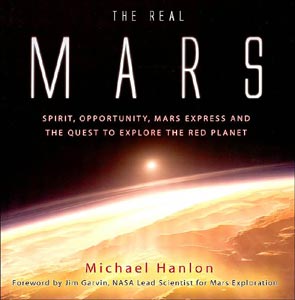Review: The Real Marsby Jeff Foust
|
| The Real Mars mixes real and fanciful images of the Red Planet with an updated history of our interest in, and knowledge of, the planet. |
At first, The Real Mars looks like just another coffee-table text. It certainly has the dimensions (about 25 centimeters on a side) and heft (over 1.5 kilograms) of such a book, and, sure enough, when you open it up it has one or more pictures on nearly every page. However, when you read the text it’s clear that this cannot be dismissed as yet another big book of Mars pictures. Hanlon provides the reader with an interesting tour of not only our knowledge of the Red Planet, but how that knowledge has shaped (and been shaped by) our culture. The book includes information up through about the spring of 2004, including the landings of and early findings from the rovers Spirit and Opportunity, as well as Europe’s Mars Express mission and the failure of the Beagle 2 lander.
Hanlon does have a tendency to veer towards the extremes of thought when it comes to Mars. This is rooted in his discussion of early 20th century studies of the planet, when a majority of the astronomical community seemed convinced by the observations of Percival Lowell and others that concluded that the planet was habitable, ignoring a few skeptics who argued that the planet was cold, dry, and lifeless—a conclusion that was eventually supported by later observations and spacecraft missions. One chapter of the book is devoted to “White Mars”, a model promoted by a handful of scientists that suggests that carbon dioxide, and not liquid water, carved the landforms seen on the surface that have long been prime evidence that the planet was once warmer and wetter. (Hanlon does note that the hypothesis has taken a beating in the last year as Spirit and Opportunity uncovered new evidence for past liquid water, but the model’s key supporters remain unbowed.) Part of another chapter is taken up with a discussion of an opposite viewpoint, namely, that Mars had far more liquid water in its early history than even the most optimistic mainstream scientists believe. And, yes, there is also a chapter about the infamous “Face on Mars”, although Hanlon is not very sympathetic to its proponents.
| “Beagle could have worked,” Hanlon writes, a conclusion that now appears rather unlikely given the new report that found that the Beagle 2 project was so poorly run that the spacecraft should never have flown. |
One person that Hanlon is clearly sympathetic to is Colin Pillinger, the British planetary scientist who led the Beagle 2 effort. Hanlon describes him as “the epitome of the Great British Eccentric” who became the “media-friendly front man” for a mission that was largely ignored in the UK until the spacecraft’s arrival and apparent demise. Hanlon is clearly taken with Pillinger and Beagle 2, and is ready to buy into the explanation that the spacecraft was doomed by atmospheric conditions that were thinner than expected when it arrived at Mars, and/or that Beagle 2 was somehow damaged by Mars Express when it separated from the orbiter. “Beagle could have worked,” Hanlon writes (emphasis in the original). That conclusion now appears rather unlikely given the harsh report—released to the public just earlier this month—that found that the Beagle 2 project was so poorly run that the spacecraft should never have flown.
Despite these excursions, The Real Mars does, overall, provide a good and up-to-date review of our knowledge of the Red Planet and prospects for future exploration (the book includes a discussion of the Vision for Space Exploration as well as ESA’s Aurora program.) There are a few minor factual errors—the book dates the landing of Mars Pathfinder in 1996, rather than 1997, for example—but nothing out of the ordinary. Of course, given the pace of discoveries made by current missions, as well as new ones like the Mars Reconnaissance Orbiter, scheduled for launch later this year, portions of this book will become out of date in the near future, but that is one of the hazards of writing about any research on the frontiers of science, not just Mars exploration. The Real Mars is a worthy addition to a Mars enthusiast’s library—regardless of what shelf it ends up on.
